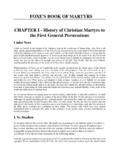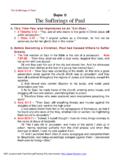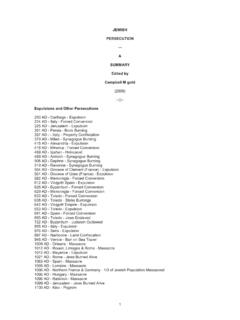Transcription of GUIDELINES ON INTERNATIONAL PROTECTION NO. 9
1 Distr. GENERAL HCR/GIP/12/09 23 October 2012 Original: ENGLISH GUIDELINES ON INTERNATIONAL PROTECTION NO. 9: Claims to Refugee Status based on Sexual Orientation and/or Gender Identity within the context of Article 1A(2) of the 1951 Convention and/or its 1967 Protocol relating to the Status of Refugees UNHCR issues these GUIDELINES pursuant to its mandate, as contained in the Statute of the Office of the United Nations High Commissioner for Refugees, in conjunction with Article 35 of the 1951 Convention relating to the Status of Refugees and Article II of its 1967 Protocol. These GUIDELINES complement the UNHCR Handbook on Procedures and Criteria for Determining Refugee Status under the 1951 Convention (Reissued, Geneva, 2011). In particular, they should be read in conjunction with UNHCR s GUIDELINES on INTERNATIONAL PROTECTION : Gender-Related persecution within the context of Article 1A(2) of the 1951 Convention and/or its 1967 Protocol relating to the Status of Refugees (May 2002); UNHCR s GUIDELINES on INTERNATIONAL PROTECTION No.
2 2: "Membership of a Particular Social Group" Within the Context of Article 1A(2) of the 1951 Convention and/or its 1967 Protocol Relating to the Status of Refugees (May 2002); and UNHCR s GUIDELINES on INTERNATIONAL PROTECTION No. 6: Religion-Based Refugee Claims under Article 1A(2) of the 1951 Convention and/or the 1967 Protocol relating to the Status of Refugees (April 2004). They replace UNHCR s Guidance Note on Refugee Claims relating to Sexual Orientation and Gender Identity (November 2008). These GUIDELINES are intended to provide legal interpretative guidance for governments, legal practitioners, decision makers and the judiciary, as well as UNHCR staff carrying out refugee status determination under its mandate. The UNHCR Handbook on Procedures and Criteria for Determining Refugee Status and the GUIDELINES on INTERNATIONAL PROTECTION are available as a compilation at: 2 I. INTRODUCTION 1.
3 In many parts of the world, individuals experience serious human rights abuses and other forms of persecution due to their actual or perceived sexual orientation and/or gender identity. While persecution of Lesbian, Gay, Bisexual, Transgender and Intersex (hereafter LGBTI )1 individuals and those perceived to be LGBTI is not a new phenomenon,2 there is greater awareness in many countries of asylum that people fleeing persecution for reasons of their sexual orientation and/or gender identity can qualify as refugees under Article 1A(2) of the 1951 Convention relating to the Status of Refugees and/or its 1967 Protocol (hereafter the 1951 Convention ).3 Nevertheless, the application of the refugee definition remains inconsistent in this area. 2. It is widely documented that LGBTI individuals are the targets of killings, sexual and gender-based violence, physical attacks, torture, arbitrary detention, accusations of immoral or deviant behaviour, denial of the rights to assembly, expression and information, and discrimination in employment, health and education in all regions around the Many countries maintain severe criminal laws for consensual same-sex relations, a number of which stipulate imprisonment, corporal punishment and/or the death In these and other countries, the authorities may not be willing or able to protect individuals from abuse and persecution by non-State actors, resulting in impunity for perpetrators and implicit, if not explicit, tolerance of such abuse and persecution .
4 3. Intersecting factors that may contribute to and compound the effects of violence and discrimination include sex, age, nationality, ethnicity/race, social or economic status and HIV status. Due to these multiple layers of discrimination, LGBTI individuals are often highly marginalized in society and isolated from their communities and families. It is also not uncommon for some individuals to harbour feelings of shame and/or internalized homophobia. Because of these and other factors, they may be inhibited from informing asylum adjudicators that their real fear of persecution relates to their sexual orientation and/or gender identity. 4. The experiences of LGBTI persons vary greatly and are strongly influenced by their cultural, economic, family, political, religious and social environment. The applicant s background may impact the way he or she expresses his or her sexual orientation and/or gender identity, or may explain the reasons why he or she does not live openly as LGBTI.
5 It is important that decisions on LGBTI refugee claims are not based on superficial understandings of the experiences of LGBTI persons, or on erroneous, culturally inappropriate or stereotypical assumptions. These GUIDELINES provide substantive and procedural guidance on the determination of refugee status of individuals on the basis of their sexual orientation and/or gender identity, with a view to ensuring a proper and harmonized interpretation of the refugee definition in the 1951 II. INTERNATIONAL HUMAN RIGHTS LAW 5. Article 1 of the Universal Declaration of Human Rights provides that all human beings are born free and equal in dignity and rights , and Article 2 declares that everyone is entitled to all the rights and freedoms set forth in this Declaration .7 All people, including LGBTI individuals, are entitled to enjoy the PROTECTION provided for by INTERNATIONAL human rights law on the basis of equality and 6. Although the main INTERNATIONAL human rights treaties do not explicitly recognize a right to equality on the basis of sexual orientation and/or gender identity,9 discrimination on these grounds has been held to be 1 For a discussion of terms, see below at III.
6 Terminology. For the purpose of these GUIDELINES , gender identity also incorporates intersex . 2 The 1951 Convention relating to the Status of Refugees was drafted not least as a response to the persecution during World War II, during which intolerance and violence cost the lives of thousands of people with a LGBTI background. See, UNHCR, Summary Conclusions: Asylum-Seekers and Refugees Seeking PROTECTION on Account of their Sexual Orientation and Gender Identity , November 2010, Expert Roundtable organized by UNHCR, Geneva, Switzerland, 30 September 1 October 2010 (hereafter UNHCR, Summary Conclusions of Roundtable ), available at: , para. 3. 3 UN General Assembly, Convention Relating to the Status of Refugees, 28 July 1951; Protocol Relating to the Status of Refugees, 31 January 1967. 4 See, UN Human Rights Council, Report of the United Nations High Commissioner for Human Rights on Discriminatory Laws and Practices and Acts of Violence against Individuals based on their Sexual Orientation and Gender Identity , 17 November 2011 (hereafter OHCHR, Report on Sexual Orientation and Gender Identity ), available at: For an overview of jurisprudence and doctrine, see also INTERNATIONAL Commission of Jurists (hereafter ICJ ), Sexual Orientation and Gender Identity in Human Rights Law, References to Jurisprudence and Doctrine of the United Nations Human Rights System, 2010, fourth updated edition, available at: ; ICJ, Sexual Orientation and Gender Identity in Human Rights Law, Jurisprudential, Legislative and Doctrinal References from the Council of Europe and the European Union, October 2007, available at.
7 ICJ, Sexual Orientation and Gender Identity in Human Rights Law: References to Jurisprudence and Doctrine of the Inter-American System, July 2007, available at: 5 See, INTERNATIONAL Lesbian, Gay, Bisexual, Trans and Intersex Association, State-sponsored Homophobia, A World Survey of Laws Prohibiting Same-Sex Activity between Consenting Adults , May 2012, available at: 6 These GUIDELINES supplement the UNHCR GUIDELINES on INTERNATIONAL PROTECTION No. 1: Gender-Related persecution Within the Context of Article 1A(2) of the 1951 Convention and/or its 1967 Protocol Relating to the Status of Refugees , 7 May 2002 (hereafter UNHCR, GUIDELINES on Gender-Related persecution ), available at: 7 UN General Assembly, Universal Declaration of Human Rights, 10 December 1948. 8 OHCHR, Report on Sexual Orientation and Gender Identity, para. 5. 9 However, some regional instruments expressly prohibit discrimination on grounds of sexual orientation. See, for example, Charter of Fundamental Rights of the European Union, Article 21, 18 December 2000, and Resolution of the Organization of American States, Human Rights, Sexual Orientation, and Gender Identity, 3 prohibited by INTERNATIONAL human rights For example, the proscribed grounds of sex and other status contained in the non-discrimination clauses of the main INTERNATIONAL human rights instruments have been accepted as encompassing sexual orientation and gender As respect for fundamental rights as well as the principle of non-discrimination are core aspects of the 1951 Convention and INTERNATIONAL refugee law,12 the refugee definition must be interpreted and applied with due regard to them, including the prohibition on non-discrimination on the basis of sexual orientation and gender identity.
8 7. The Yogyakarta Principles on the Application of INTERNATIONAL Human Rights Law in relation to Sexual Orientation and Gender Identity were adopted in 2007 by a group of human rights experts and, although not binding, reflect well-established principles of INTERNATIONAL They set out the human rights PROTECTION framework applicable in the context of sexual orientation and/or gender identity. Principle 23 outlines the right to seek and enjoy asylum from persecution related to sexual orientation and/or gender identity: Everyone has the right to seek and enjoy in other countries asylum from persecution , including persecution related to sexual orientation or gender identity. A State may not remove, expel or extradite a person to any State where that person may face a well-founded fear of torture, persecution , or any other form of cruel, inhuman or degrading treatment or punishment, on the basis of sexual orientation or gender identity.
9 III. TERMINOLOGY 8. These GUIDELINES are intended to be inclusive of and relevant to the range of claims relating to sexual orientation and/or gender identity. The concepts of sexual orientation and gender identity are outlined in the Yogyakarta Principles and this terminology is also used for the purposes of these GUIDELINES . Sexual orientation refers to: each person s capacity for profound emotional, affectional and sexual attraction to, and intimate relations with, individuals of a different gender or the same gender or more than one gender .14 Gender identity refers to: each person s deeply felt internal and individual experience of gender, which may or may not correspond with the sex assigned at birth, including the personal sense of the body and other expressions of gender, including dress, speech and mannerisms .15 9. Sexual orientation and gender identity are broad concepts which create space for self-identification.
10 Research over several decades has demonstrated that sexual orientation can range along a continuum, including exclusive and non-exclusive attraction to the same or the opposite Gender identity and its expression also take many forms, with some individuals identifying neither as male nor female, or as both. Whether one s sexual orientation is determined by, inter alia, genetic, hormonal, developmental, social, and/or cultural influences (or a combination thereof), most people experience little or no sense of choice about their sexual While for most people sexual orientation or gender identity are determined at an early age, for others they may continue to evolve across a person's lifetime. Different people realize at different points in their lives that they are LGBTI and their sexual and gender expressions may vary with age, and other social and cultural 10. Refugee claims based on sexual orientation and/or gender identity often emanate from members of specific sub-groups, that is, lesbian, gay, bisexual, transgender, intersex and queer19 individuals (usually abbreviated as LGBT , LGBTI or LGBTIQ 20).


















